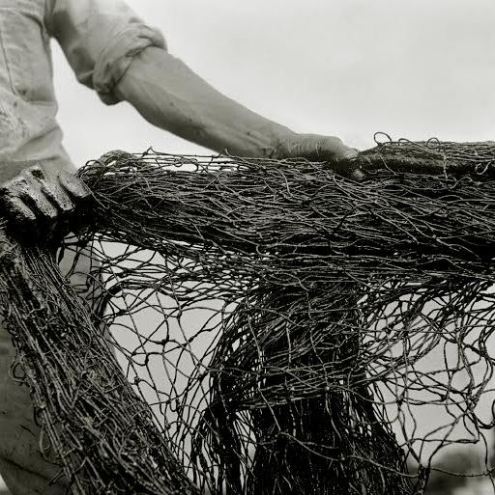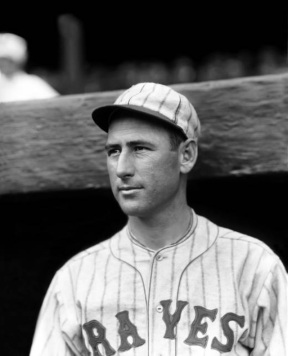When thirty-year-old Brooklyn photographer Sol Libsohn visited Hatteras Island, North Carolina, in 1945 to take a few photos for Standard Oil, he probably didn’t realize that he’d soon end up creating what many consider the definitive portrait of “old” island life on the Outer Banks. Twenty years later, completion of the Bonner Bridge over Oregon Inlet ushered in a new world on Hatteras. Some things, like health care and education, got better. But cars, tourism, and the collapse of the old maritime culture have taken their toll.
Made as stock commercial photos for use in the oil company’s magazine, Libsohn’s images are enormously popular on the coast. His idyllic, romantic vision of island life before the roads came in is far from accurate and leaves much unsaid, but Libsohn beautifully captured the archetypes of the old days and ways, before they began their slow disappearance in the 1960s. Yet the actual stories of Hatteras are still hidden in these pictures.
The engineers and roughnecks who descended on this part of North Carolina in the final months of World War II were coming to one of the more remote and hard-to-get-to parts of the American South in those days. Culturally distinct from the rest of the state and often at loggerheads with it, the inhabitants of these scrawny barrier islands were both isolated and at the center of a great Atlantic crossroads.
Famous as the “Graveyard of the Atlantic,” Hatteras and the treacherous Diamond Shoals became the deathbed of many a ship in the days of sail. Some island families even came here by accident, stranded on their way to other ports of call. Though the mainstay of life was always fishing, a frequent lucky windfall — shipwrecks — brought exotic goods and even scarce household items. Bananas, canned food, clocks, bedsteads, and sometimes cars, all of which could be legally salvaged or auctioned off, came to Hatteras in the hold of wrecks. In this place where wood is scarce, it is remarkable that many old Hatteras houses were built from doomed ships or the cargo of wrecked lumbering vessels.
 (NC Route 12, today the only highway on the Outer Banks, was a dirt path seventy years ago.)
(NC Route 12, today the only highway on the Outer Banks, was a dirt path seventy years ago.)
Sol Libsohn, who died in 2001, came to Hatteras to illustrate the theme “There’s a drop of oil in everyone.” Petroleum, in fact, was at the center of a forgotten drama enacted here during the early years of World War II. The little-known “Battle of the Atlantic,” when German U-boats sank hundreds of merchant marine vessels and oil tankers transporting war goods to Allied Europe, was waged from Newfoundland to Texas, but the waters off the Outer Banks became one of the major targets of Hitler’s underwater navy.
Most of the older generation who lived on Hatteras in those years can remember an ominous glow on the horizon, glimpsed over dunes at night, as stricken tankers burned at sea a few miles out. In a strange boost to North Carolina tourism, recreational divers are now rediscovering and photographing some of these vessels — and their attackers. In 2014, the German submarine U-576 was found thirty miles off Cape Hatteras. Forty-five German sailors died when it was sent to the bottom on July 14, 1942.
 (U-352 was sunk off “Torpedo Alley” on May 9, 1941, and is one of the most visited dive sites along North Carolina’s coast. Sumberged Sports.)
(U-352 was sunk off “Torpedo Alley” on May 9, 1941, and is one of the most visited dive sites along North Carolina’s coast. Sumberged Sports.)
Many stories, some surely mythic, proliferated about German crewmen rowing into towns like Morehead City on rubber dinghies at dark to watch movies in local theaters. A media blackout and the sheer remoteness of the place kept most Americans from knowing much about the war waged off North Carolina’s beaches in 1941 and ’42. Local lore, now told by adults who were children back then, recalls the horrible fate of sailors at sea. Bodies — American, English, German — would sometimes wash up on what became Cape Hatteras and Cape Lookout National Seashores, horribly disfigured after swimming or floating through burning oil slicks on the ocean’s surface.
At war’s end, Standard Oil began exploring the bottom of Pamlico Sound for domestic petroleum deposits. For a while, an oil derrick even sat near the Cape Hatteras lighthouse, vying with it to be the tallest structure around. The oil men gave up after drilling shafts down to 10,000 feet and finding nothing. Recently, plans for another go at offshore drilling along the Virginia and North Carolina coast have sparked controversy, especially after the BP disaster in the Gulf of Mexico.
Roy Stryker, who headed the Farm Security Administration’s Information Division and launched the career of many of the great documentary photographers of the 1930s and ’40s, worked with Standard Oil to send the self-taught Libsohn to Hatteras, purportedly to show the uses of oil. A Jewish kid from Brooklyn, Libsohn had knack for getting along with working-class Americans. He went on to create a great record of many of the stock subjects of Edward Hopper’s America — “late night portraits of drivers and their vehicles,” his obituary in the New York Times runs, “waitresses and diners, roadside attractions, small towns along the Pennsylvania Turnpike. . . the hurly-burly life in the Ringling Brothers and Barnum & Bailey Circus.” He taught at Princeton for years. Most of his images are housed at the University of Louisville’s Photographic Archives in Kentucky.
(Dixie Burrus. Photo by Sol Libsohn. Photographic Archives, University of Louisville.)
Dixie Burrus Browning was fifteen years old when Libsohn photographed her in June 1945. She doesn’t recall why he took her picture. Her father was Maurice “Dick” Burrus, a Hatteras native who had played professional baseball for teams in Philadelphia, Boston, and Indianapolis and was once scouted in person by the great baseball manager Connie Mack. After returning to Hatteras Island at the start of the Great Depression, Dick Burrus became a commercial fisherman and a Texaco dealer — perhaps the reason why Libsohn photographed his daughter.
Dixie married Lee Browning at age 20. They raised their children in Winston-Salem, North Carolina, where the couple lived for forty-nine years before returning to the Outer Banks. Dixie has written over a hundred romance and historical novels and is a prolific painter who runs a studio in Buxton. She spoke to me in her home in December 2008 and told me about life in Hatteras back in the ’40s.
Dixie Burrus Browning: My daddy was a baseball player. He played first base with the Philadelphia Athletics and the Boston Braves and some minor teams. And he had a hernia. That ended his career. Unfortunately, he stocked away everything in the stock market, and he got out of baseball in 1929, so you can imagine what that was like. Perfect timing.
If you really wanted to understand Hatteras, you had to be here, living on collards and crokers during the Depression, when most people didn’t even realize there was a Depression, because they went right on living the way they always had. And it was a subsistence thing, pretty much. But you could hunt. You could fish. You didn’t have to have licenses for everything, because there wasn’t any law down here. No sheriff. You didn’t have to have a driver’s license, because there were no highways. It was a good place to grow up, but Lord, I’m glad my children didn’t grow up here. And my grandchildren? Children today, in this generation, they couldn’t handle it.
My brother was a year and a half younger than I am. When he was about twelve, he became captain of daddy’s shrimp boat. Daddy was a Texaco dealer, but he had a shrimp boat. It had a crew of two, a captain and one mate, I guess you’d call them, and they were both Hyde County farmers who didn’t know a whole lot about running a shrimp boat. And so finally daddy fired them, and my brother Steve at age twelve became captain of a shrimp boat.
And during one of the hurricanes, what you’d do was, you took the boat offshore and anchored it so it’ll swing into the wind. And so Steve took the trawler off into the sound and anchored it and rode out the storm in it. And nobody worried about it. Now can you see a twelve-year-old given that responsibility today?
It was a working thing. Up at 3:30 in the morning. And they all headed out, in a row, early in the morning before daylight. And the first person who found the area where there was shrimp, I can’t remember if they threw a flag over it or what, but then all the trawlers slowly circled, dragging that area all day. And the first day Steve came in as captain, he sold high man. He had caught more than anybody else that was out there and that was a big thrill.
He died a good while ago, just before he turned fifty. [Steve Burrus worked for IBM and helped install computers on nuclear submarines. He succumbed to a rare brain cancer in 1981.]
And then we hunted, too, when we were children. We had a bolt action rifle, and for safety’s sake, I carried the bolt and walked behind Steve, who carried the rifle. And we followed the shoreline looking for geese, ducks, anything edible. And if we saw something, by the time we got the rifle back together again, they were gone. So we never shot anything, but people did. We had stewed goose with rutabagas. We had sea turtle. That is the best meat. It’s un-P.C. to talk about it now, but I don’t give a damn about P.C. It was delicious meat. One flipper would feed the family, but it was awful to clean. It had layers of gobby, sticky fat and leathery skin. But it was the sweetest, best meat. It was the color of beef, I guess. But it was milder than beef. It was just delicious. Turtle stew, turtle hash, anyway you wanted to cook it. Turtle burgers, we had those, too.
 (Dixie Burrus and Little Lee Peale, 1940s.)
(Dixie Burrus and Little Lee Peale, 1940s.)
But other than what we could catch or hunt here, we depended on the freight boats. They came over a couple of times a week with whatever didn’t sell on the mainland. You know, hamburger that was black. And we grew up having canned milk, because you couldn’t get bottled milk that was fresh. It would have been sour by the time it got here. These weren’t refrigerated boats.
And we traveled on the freight boats, too. My momma was from Elizabeth City, my grandmamma lived there. And it was about an eight-hour trip. They had absolutely no passenger accommodation. One space for cars.
I have a ship model I did of my granddaddy Dozier Burrus’ boat. The ship was called the Hamlet. He bought the Hamlet after he retired from the West Indies trade. He used to take daddy and daddy’s brothers with him on some of the runs. Occasionally he’d take his daughters, too, to go up to Baltimore City or Washington City. The West Indies trade was rum and molasses, mostly. They sailed down to the Caribbean. I don’t know that he owned the ships that he was captain of. One of them — I loved the name! — was called the Bessie Mae and Annie. I named a painting after it.
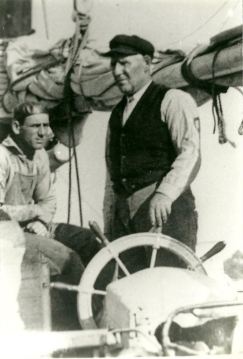 (Almy Burrus and Capt. Ethelbert Dozier Burrus at the wheel of the Bugeye.)
(Almy Burrus and Capt. Ethelbert Dozier Burrus at the wheel of the Bugeye.)
My daddy’s mother was Achsah Williams. She died when daddy was about six years old. (He was the youngest of a slew of children.) And granddaddy brought a new bride home, Miss Maggie. Maggie Douglass, from Wilmington. He left her here with his children while he went off to sea again. So we had Miss Maggie when we were growing up. And she’d tease us and play with us and walk to the beach every morning with old paint buckets to get gravel for the chickens she kept. She kept our chickens. She lived in the back part of our house. Her clothes she made out of Pillsbury feed sacks. Bloomers that would tie. Cotton stockings that she didn’t darn — she would patch them with a gingham patch. She wore high-top tennis shoes and sun bonnets.
After she died, we were packing away her things, and in the bottom of the trunk, there were two golden earrings and a black chiffon blouse. And it just struck me: Miss Maggie was a young woman with dreams, and she married Granddaddy Dozier and he went off and left her at home. I’ve often wished I could go back and talk to her and just hug her. I wrote a novel about her, The Mariner’s Bride.
Lots of ships got sunk around here by the German submarines in World War II. I remember taking a walk on the beach after they blew up the Australia and seeing a metal lifeboat with bullet holes all down the side of it. It had been strafed, obviously. There was just a straight line of machine-gun holes right down the length of it. And part of a carton of containers or something. K-ration, or C-ration, or one of those rations, small cans. The container had what looked like blood stains on it. We didn’t touch any of that stuff. And there were old pieces painted grey that were part of the deck gear that we recognized as such. But you know, you’re kids, you can’t drag everything home. There was stuff everywhere. The beach was littered. And we chased a muskrat all around there.
I know Shank Austin found a body there.
It was really rough. Even as a child, it was the reality at that time.
I remember one specific night when everything rattled. Everything that was glass in the house, including the window, just rattle-rattle-rattled. It was enough to wake you up. I woke up and looked out the window. It was over the Slash, through the marsh. We had a pretty clear shot of the ocean. You couldn’t see the ocean itself, because there were houses and things in between, but you could see three distinct glows at night. You could see the glow of burning oil. The German submarines had gotten three of them that night.
 (A man, probably Millard O’Neal, walks over “The Slash” in Hatteras Village. Photo by Sol Libsohn. Photographic Archives, University of Louisville.)
(A man, probably Millard O’Neal, walks over “The Slash” in Hatteras Village. Photo by Sol Libsohn. Photographic Archives, University of Louisville.)
My uncle, Uncle Almy, was in charge of the Hatteras Inlet Coast Guard Station, which at that time was on the north end of Ocracoke Island. He and his crew went out there in open boats. I’m not sure if that was when the Australia was torpedoed (you know, I was a child then, I get things mixed up), but Uncle Almy and his crew saw the surviving sailors on one of those ships. The stern was up in the air looking down at the water and the tanker was surrounded by burning oil. The surviving crew members had to dive in and swim under. Not many of them made it. Somewhere I have pictures of Uncle Almy and I think one or two survivors when they got back to the station.
After the Australia was sunk, they had a vendue. That’s traditional down here. They’ve been doing that for the past couple of hundred years. There was a wreck commissioner who came down. He would oversee the sale of things. And daddy bought some things off the Australia. He bought the Texaco flag. Big, bedspread-sized, wool bunting. And he bought some of the semaphore flags, but not all. Momma put an old quilt in between the layers and quilted them together.
 (The Texaco tanker Australia went down off Diamond Shoals on the night of March 16, 1942, en route from Texas to Connecticut. Four crewmen were killed in the explosion.)
(The Texaco tanker Australia went down off Diamond Shoals on the night of March 16, 1942, en route from Texas to Connecticut. Four crewmen were killed in the explosion.)
 (Two survivors of the Australia at Hatteras Inlet Coast Guard Station.)
(Two survivors of the Australia at Hatteras Inlet Coast Guard Station.)
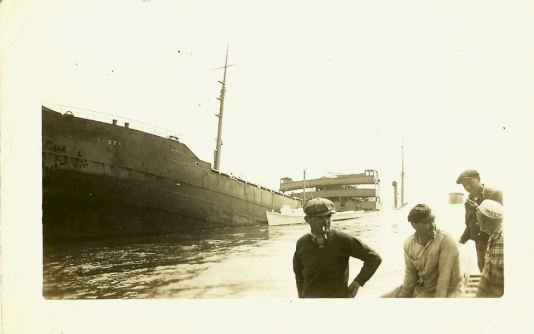 (Local Hatteras islanders next to the wreck of the Australia.)
(Local Hatteras islanders next to the wreck of the Australia.)
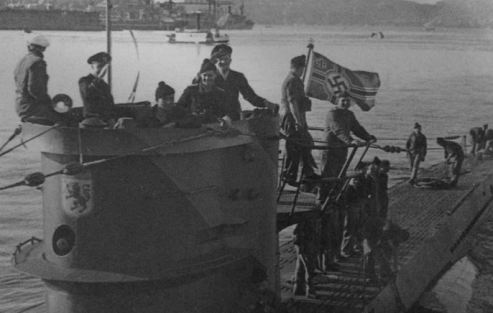 (U-332, which torpedoed the 11,000-ton tanker Australia in 1942, was sunk by an RAF Liberator bomber in May 1943 off Cape Finisterre in northwestern Spain. All 45 of its crewmembers died. This photo shows the crew of a similar boat, U-576, found off Cape Hatteras in 2014.)
(U-332, which torpedoed the 11,000-ton tanker Australia in 1942, was sunk by an RAF Liberator bomber in May 1943 off Cape Finisterre in northwestern Spain. All 45 of its crewmembers died. This photo shows the crew of a similar boat, U-576, found off Cape Hatteras in 2014.)
The first time I went to New York was with Ernal Foster and my daddy. I was maybe ten or eleven years old. I had long pigtails.
I remember coming out of the Holland Tunnel. There was a woman standing outside the tunnel dressed in a man’s suit. That made such an impression on me. There was nobody else in sight. No cars, no traffic, no nothing. It must have been in the wee hours of the morning. I thought that was the strangest place, New York.
Out on Long Island, we stopped at a place called Pop’s Pony Yard for me to ride a pony. Never mind that I had ridden bareback on the beach here at Hatteras. There was me in a dotted Swiss dress with a long sash and my pigtails, sitting on the back of the pony, jogging along.
 (A young Dixie Burrus, around 1940.)
(A young Dixie Burrus, around 1940.)
I graduated in a class of three at Hatteras High. It would have been more, except that the boys, as soon as they got to be sixteen, they’d leave here and go sign up with the Merchant Marine. So our class kind of leaked. I think we got the kind of teachers that couldn’t get a job anywhere else.
Just about the sickest I have ever been (and I was always prone to sea-sickness) was traveling back from Elizabeth City on one of those freight boats. There were two boats named the Cathleen and the Mallinson, but I can’t remember which one it was.
Anyway, it was a freight boat, loaded up to the gills except right up in the forepeak. And then there was all that cargo. There were just planks like this that held it back. We left late in the afternoon, and it was already rainy and stormy, and the water was real rough. I think there were two other girls and me. We had been to Louisburg to a Methodist youth retreat or something like that.
So when it started getting kind of rough — and, as I said, there were absolutely no amenities — they sent us below. We opened the hatch up in the forepeak, and climbed down a ladder, and sat on upturned cases or crates or whatever. And by then the water was sloshing about mid-way up our shins and we just sat there. And the bow was rocking back and forth. And we were getting sick. And every time the boat would go like this, with all that freight piled up behind us, the boards would creak and groan. And like I said, it was an eight-hour trip. In pitch darkness.
First one and then other of us would get sick. It was hot, miserable, stifling, stinky and I couldn’t stand it anymore. So I climbed up the ladder and just got this much of me outside and closed the hatch over here. And it was real foggy then. Still rough, not raining, but just foggy. But I could breathe, and the seas would wash over, and then wash over, and then wash over, and then wash over. And it was refreshing. Then all of a sudden this figure materialized, just head and shoulders, because the rest of it was foggy, and he said: “SON. . . You got to go back below!”
Several of the old men called all children “son,” male or female, it didn’t matter.
But they haven’t called me “son” in a few years.
 (Dixie Burrus heading out to Diamond Shoals. More of her photos are available at the Hatteras Island Genealogical and Preservation Society’s website.)
(Dixie Burrus heading out to Diamond Shoals. More of her photos are available at the Hatteras Island Genealogical and Preservation Society’s website.)
Stephen Taylor, staylor336 [AT] gmail.com
